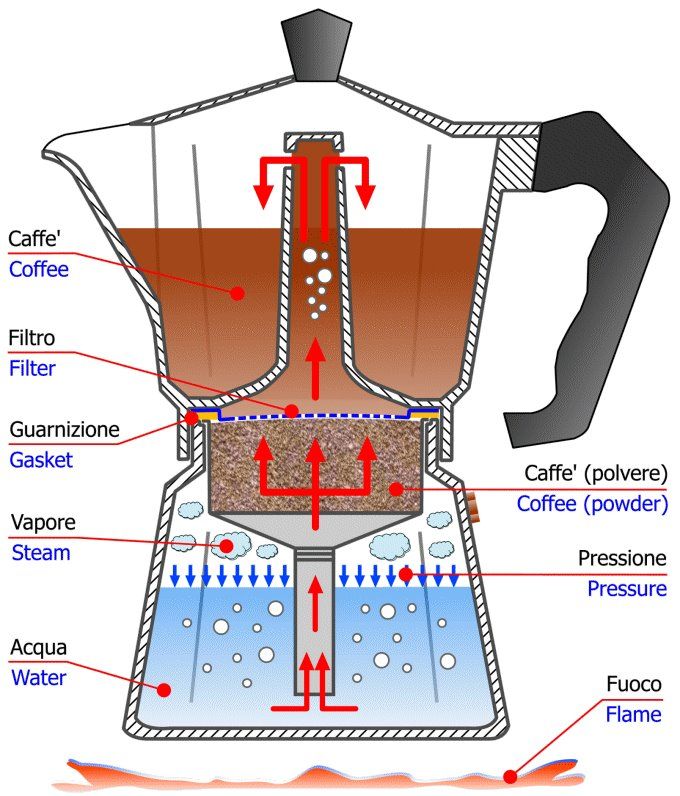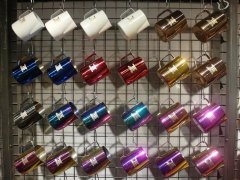What is a mocha pot and how to use it
Mocha pot (Moka Pot) is a tool for extracting espresso, which is widely used in Europe and Latin American countries, and is called "Italian trickle filter pot" in the United States.
The mocha pot has a two-layer structure, and when the water in the lower part is boiled, it is sprayed into the upper half of the pot through a mesh filter containing coffee powder. Although hot water can be injected into finely ground coffee powder without air pressure, this is not strictly a concentrated extraction, but rather close to dripping, but the coffee made by the mocha pot still has the concentration and flavor of Italian coffee Espresso. The earliest mocha pot was made by the Italian Alfonso Bialetti in 1933, and his company, Bialetti, has always been famous for producing this kind of coffee pot called Moka Expres.
Bialetti's advertisement for mocha pot, 1961
The traditional mocha pot is made of aluminum and can be heated by open fire or electric stove. Because this aluminum mocha pot cannot be heated on an electromagnetic stove, modern mocha pots are mostly made of stainless steel, and there are electric heating mocha pots like electric kettles.
Use precautions: water level: use warm water, the water level is 0.5 cm under the safety valve. The safety valve will automatically relieve pressure when the lower pot pressure is too high, in order to prevent safety accidents. If the water level is higher than the safety valve, the function of the safety valve can not play normally. Coffee powder: coffee powder is medium-fine-grained and filled with powder trough. when filling the powder, vibrate the powder trough properly so that the coffee powder is evenly distributed. after filling it, gently press the surface with your fingers to make the powder denser. Process analysis: initial heat: after the kettle is heated, the air part expands by heat, resulting in pressure, and the water reaches the powder trough through the aqueduct. After soaking in water, the coffee powder expands rapidly to form pressed powder. At this time, the water in the lower pot is resisted by pressed powder, and the closed pressure in the lower pot continues to increase. The purpose of the first heat is to raise the water level to the position of the powder trough and let the coffee powder form cakes, so there is no need for high pressure and high temperature, as long as the heat is low. If you open the lid of the upper pot to observe, a small amount of coffee will flow out, and then the coffee will no longer flow out. Pressurization: after the coffee cakes in the powder trough, the pressure in the lower pot begins to increase, turn the fire to medium heat, and let the pressure continue to increase. Extraction: fire. The pressure of the lower pot is increased to balance with the resistance of the coffee pressed powder, turn on the fire, and let the pressure exceed the critical point of this balance. Under the action of the continuous fire, let the water quickly pass through the coffee pressed powder to get the coffee liquid with complete extraction and balanced taste. Raise a pot: turn off the fire. Turn off the fire as soon as there is a steam purr in the upper pot of coffee. Then let the coffee pot stand for about 30 seconds. There is a proper distance between the aqueduct of the lower pot and the base of the lower pot, and if you continue to heat, there is still hot water passing through the powder trough, and the extracted coffee has a residual smell of coffee; in addition, if you shake the lower pot, the pressure of the lower pot will increase intermittently, or because the water level of the lower pot is not balanced, there is still water passing through the powder trough. Both reasons cause coffee to be overextracted or overheated. Taste: remove the coffee pot from the stove. At this time, it is still necessary to rest the coffee pot for about 30 seconds to 1 minute. Because the coffee extraction process goes through three different stages, it needs to be re-homogenized in the static process. After the taste of coffee will no longer have the phenomenon of uneven ups and downs, very soft. Operation effect: after pouring out the coffee liquid, wait for the coffee pot to cool (or rinse the pot with cold water to cool), unscrew the upper pot and observe the pressed powder in the powder trough. At this point, the pressed powder should be completely cake-shaped, without collapses and voids. If there are collapses and voids, the effect of coffee extraction will not be good. Press with your fingers, it should be dense and slightly elastic.

Important Notice :
前街咖啡 FrontStreet Coffee has moved to new addredd:
FrontStreet Coffee Address: 315,Donghua East Road,GuangZhou
Tel:020 38364473
- Prev

How to choose the bean grinder? Take three minutes to read it and give yourself a choice of thinking and comparison.
I remember that I was very impressed that there was a TIAMO blade electric bean grinder at home, which is commonly known as the bean chopper, so every time I went home to make American coffee, I had to use it to grind the beans first, but the point came. I didn't know how fine it was. My mother told me that the finer the better (there was really no idea at that time), so I had to open the lid after grinding it for a while.
- Next

Foam and latte are two necessary skills for baristas. Choose the right milk jar.
Professional coffee knowledge exchange more coffee bean information Please follow the coffee workshop (Wechat official account cafe_style) foam handling and latte pulling are two necessary skills for baristas, neither of which is as simple as imagined, especially in the beginner period, choosing a suitable flower cup may help you. Now there are many kinds of flower cup brands on the market. No.
Related
- What is the Philharmonic pressure? How to use Philharmonic pressure to make delicious coffee
- Why does a hand grinder have more fine powder than an electric grinder?
- In addition to the hot mom, what is the difference between the versions of EK43 | ditting and Mahdi ek43?
- What kind of equipment do you need to make coffee by hand? Introduction to novice starter cooking equipment tools
- Espresso needs to be ground how thick and thin scale entry Italian Coffee Machine Bean Grinder investigation and Grinding course
- How much does it cost to open a small private cafe? How much does it cost to learn coffee? How to operate it?
- The difference between the flavor characteristics of hand-brewed coffee and coffee maker is hand-brewed coffee really better than coffee maker? Can I use a coffee machine to make coffee beans by hand?
- The difference between 01 and 02 of hario v60 filter cup what is the difference between 01 and 02 filter cup opening and cooking flavor
- What's the difference between the smart cup and the French kettle? Which is better, the French kettle or the Smart Cup?
- What's the difference between a smart cup and a V60 filter cup? The difference between the taste of smart cup and hand-brewed coffee

